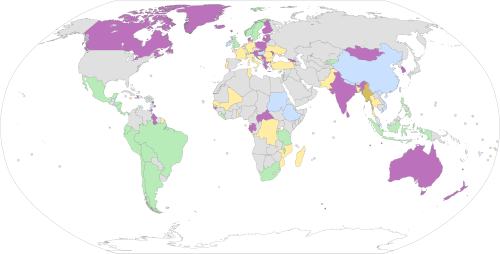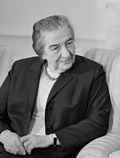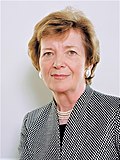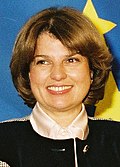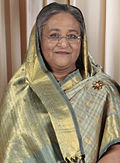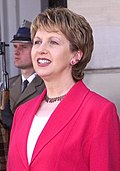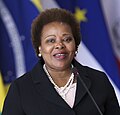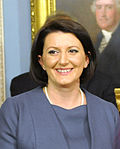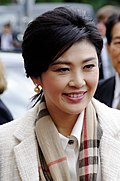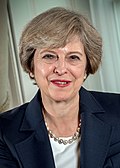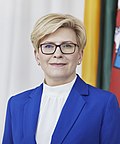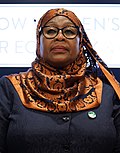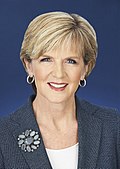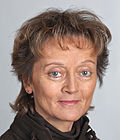Top Qs
Timeline
Chat
Perspective
List of elected and appointed female heads of state and government
From Wikipedia, the free encyclopedia
Remove ads
The following is a list of women who have been elected or appointed head of state or government of their respective countries since the interwar period (1918–1939). The first list includes female presidents who are heads of state and may also be heads of government, as well as female heads of government who are not concurrently head of state, such as prime ministers. The list does not include Queens regnant who are heads of state (but not of government).[b]
Map showing countries which currently have women as heads of state or government, counting governors-general but not monarchs.
Female head of government
Female head of state
Female head of state and female head of government
Female prime minister/state counselor acting as deputy to the combined head of state and government (de facto leader)
- Three former sovereign states had a female head of state or government in the 20th century: East Germany, Tannu Tuva and Yugoslavia.
Khertek Anchimaa, of the mostly unrecognized and now defunct Tuvan People's Republic, is regarded as the "first ever elected woman head of state in the world", although not in multiparty, free and fair elections. The wife of the nation's Supreme Leader, she is the first woman to be elected Chairman of a country. She became the chairwoman of the country's presidium in 1940.[1][2]
The first woman to be elected as prime minister of a country was Sirimavo Bandaranaike of Ceylon (present-day Sri Lanka), when she led her party to victory in the July 1960 general election.[3][2]
The first woman to serve as president of a country was Isabel Perón of Argentina, who served as the country's vice president and succeeded to the presidency in July 1974 upon the death of her husband.[4][2]
The first woman elected president of a country was Vigdís Finnbogadóttir of Iceland, who won the 1980 presidential election as well as three subsequent elections, remaining in office for a total of 16 years, which makes her the longest-serving non-hereditary female head of state in history.[5][2]
The first democratically elected female prime minister of a Muslim majority country was Benazir Bhutto of Pakistan, who led her party to victory in the 1988 general election and later in 1993, making her the first woman democratically elected leader of any Muslim nation.[6] Bhutto was also the first of only two non-hereditary female world leaders who gave birth to a child while serving in office, the other being Jacinda Ardern of New Zealand.[7]
The longest-tenured female non-hereditary head of government is Sheikh Hasina of Bangladesh. She served as the country's prime minister from June 1996 to July 2001 and again from January 2009 until August 2024, for a combined total of over 20 years.[8]
The prime ministers of Equatorial Guinea, Mozambique, Namibia, Peru, and Uganda are included in the list of elected or appointed female deputy heads of government but not in the list of elected or appointed female deputy heads of state, as they are neither heads of government, nor deputy heads of state due to the existence of the office of vice president in these countries, whereas the prime ministers of South Korea and Sri Lanka (post-1978) are included in both of those lists.
Currently, Barbados, Iceland, and Trinidad and Tobago are the only republics in the world where both the serving head of state and head of government are women. Honduras, the Marshall Islands, Mexico, Namibia, Peru, Suriname, and Tanzania are republics where the female President is the combined head of state and government.
Remove ads
Elected or appointed female chief executives
Summarize
Perspective
This list includes women who were appointed by a governing committee or parliament where heads of state or government are not directly elected by citizens. The list does not include women chosen by a hereditary monarch. Interim heads of state or government are listed in italics.
Elected or appointed acting female chief executives
This list includes women elected or appointed in an acting capacity, wherein they assumed a vacated office on a temporary basis.
Remove ads
Female members of collective head-of-state bodies
Remove ads
Female viceregal representatives
Summarize
Perspective
Below are women who have been appointed representatives of heads of state, such as female governors-general and French representatives of Andorra. As governors-general are appointed representatives of the monarch of the Commonwealth realms (currently Charles III) and the French Representatives of Andorra are appointed representatives of the French Co-Prince of Andorra (currently Emmanuel Macron), they act as heads of state and carry out on a regular basis the functions and duties associated with such a role in the Commonwealth realms (excluding the United Kingdom, which has no governor-general, as the monarch of the Commonwealth realms primarily resides there) and Andorra, respectively.
Acting female viceregal representatives
This list includes women appointed as viceregal representatives in an acting capacity, wherein they assumed a vacated office on a temporary basis.
Remove ads
See also
- Women in government
- List of elected and appointed female deputy heads of state
- List of elected and appointed female deputy heads of government
- List of the first women heads of state and government in Muslim-majority countries
- List of Muslim women heads of state and government
- List of female monarchs
Notes
- Heads of government of constitutional monarchies without a vice-regal representative are included.
- As of 2024, there is one female monarch of a sovereign state, Ntfombi of Eswatini (as Queen Mother and co-head of state with her son, King Mswati III).
- Tannu Tuva was a partially recognized state which existed between 1921 and 1944. Only the Soviet Union and Mongolia recognized its independence, and it was later absorbed into the Soviet Union in 1944.
- Since 1978, Prime Ministers of Sri Lanka are no longer executive heads of government.
- Transkei was a partially recognized state which existed between 1976 and 1994. The only United Nations member state that recognized its independence was South Africa, and it was later reabsorbed into South Africa in 1994.
- Transnistria is an unrecognized state which declared its independence in 1990. It does not have any international recognition as an independent nation by United Nations member states, and is considered by the international community to be part of the Republic of Moldova.
- Northern Cyprus is a partially recognized de facto state. Only Turkey recognizes its independence, while the remainder of the international community considers it to be part of the Republic of Cyprus.
- Following the constitutional reform in March 2024 which transformed Togo from a presidential system to a parliamentary one and where the role of prime minister became the most powerful job in the country.
Remove ads
References
External links
Wikiwand - on
Seamless Wikipedia browsing. On steroids.
Remove ads


